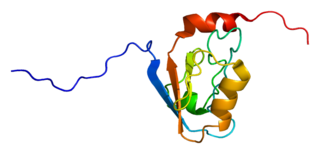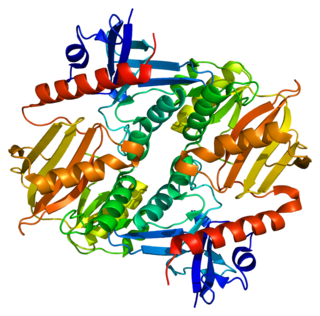
Synaptosomal-Associated Protein, 25kDa (SNAP-25) is a Target Soluble NSF (N-ethylmaleimide-sensitive factor) Attachment Protein Receptor (t-SNARE) protein encoded by the SNAP25 gene found on chromosome 20p12.2 in humans. SNAP-25 is a component of the trans-SNARE complex, which accounts for membrane fusion specificity and directly executes fusion by forming a tight complex that brings the synaptic vesicle and plasma membranes together.

Neurexins (NRXN) are a family of presynaptic cell adhesion proteins that have roles in connecting neurons at the synapse. They are located mostly on the presynaptic membrane and contain a single transmembrane domain. The extracellular domain interacts with proteins in the synaptic cleft, most notably neuroligin, while the intracellular cytoplasmic portion interacts with proteins associated with exocytosis. Neurexin and neuroligin "shake hands," resulting in the connection between the two neurons and the production of a synapse. Neurexins mediate signaling across the synapse, and influence the properties of neural networks by synapse specificity. Neurexins were discovered as receptors for α-latrotoxin, a vertebrate-specific toxin in black widow spider venom that binds to presynaptic receptors and induces massive neurotransmitter release. In humans, alterations in genes encoding neurexins are implicated in autism and other cognitive diseases, such as Tourette syndrome and schizophrenia.

LRRTM1 is a brain-expressed imprinted gene that encodes a leucine-rich repeat transmembrane protein that interacts with neurexins and neuroligins to modulate synaptic cell adhesion in neurons. As the name implies, its protein product is a transmembrane protein that contains many leucine rich repeats. It is expressed during the development of specific forebrain structures and shows a variable pattern of maternal downregulation.

Peripheral plasma membrane protein CASK is a protein that in humans is encoded by the CASK gene. This gene is also known by several other names: CMG 2, calcium/calmodulin-dependent serine protein kinase 3 and membrane-associated guanylate kinase 2. CASK gene mutations are the cause of XL-ID with our without nystagmus and MICPCH, an X-linked neurological disorder.

Disks large homolog 3 (DLG3) also known as neuroendocrine-DLG or synapse-associated protein 102 (SAP-102) is a protein that in humans is encoded by the DLG3 gene. DLG3 is a member of the membrane-associated guanylate kinase (MAGUK) superfamily of proteins.

Disks large homolog 2 (DLG2) also known as channel-associated protein of synapse-110 (chapsyn-110) or postsynaptic density protein 93 (PSD-93) is a protein that in humans is encoded by the DLG2 gene.

Latrophilin 1 is a protein that in humans is encoded by the ADGRL1 gene. It is a member of the adhesion-GPCR family of receptors. Family members are characterized by an extended extracellular region with a variable number of protein domains coupled to a TM7 domain via a domain known as the GPCR-Autoproteolysis INducing (GAIN) domain.

Neurexin-1-alpha is a protein that in humans is encoded by the NRXN1 gene.

Syntaxin-2, also known as epimorphin, is a protein that in humans is encoded by the STX2 gene.

Neuroligin-3 is a protein that in humans is encoded by the NLGN3 gene.

Disks large-associated protein 1 (DAP-1), also known as guanylate kinase-associated protein (GKAP), is a protein that in humans is encoded by the DLGAP1 gene. DAP-1 is known to be highly enriched in synaptosomal preparations of the brain, and present in the post-synaptic density.

Neuroligin-4, X-linked is a protein that in humans is encoded by the NLGN4X gene.

Disks large-associated protein 2 is a protein that in humans is encoded by the DLGAP2 gene.

Neurexin-2-alpha is a protein that in humans is encoded by the NRXN2 gene.

Neurexin-3-alpha is a protein that in humans is encoded by the NRXN3 gene.

ERC protein 2 is a protein that in humans is encoded by the ERC2 gene.

Neurexophilin-1 is a protein that in humans is encoded by the NXPH1 gene.

Neuroligin-2 is a protein that in humans is encoded by the NLGN2 gene.

Neuroligin (NLGN), a type I membrane protein, is a cell adhesion protein on the postsynaptic membrane that mediates the formation and maintenance of synapses between neurons. Neuroligins act as ligands for β-neurexins, which are cell adhesion proteins located presynaptically. Neuroligin and β-neurexin "shake hands", resulting in the connection between two neurons and the production of a synapse. Neuroligins also affect the properties of neural networks by specifying synaptic functions, and they mediate signalling by recruiting and stabilizing key synaptic components. Neuroligins interact with other postsynaptic proteins to localize neurotransmitter receptors and channels in the postsynaptic density as the cell matures. Additionally, neuroligins are expressed in human peripheral tissues and have been found to play a role in angiogenesis. In humans, alterations in genes encoding neuroligins are implicated in autism and other cognitive disorders. Antibodies in a mother from previous male pregnancies against neuroligin 4 from the Y chromosome increase the probability of homosexuality in male offspring.

Synapsin II is the collective name for synapsin IIa and synapsin IIb, two nearly identical phosphoproteins in the synapsin family that in humans are encoded by the SYN2 gene. Synapsins associate as endogenous substrates to the surface of synaptic vesicles and act as key modulators in neurotransmitter release across the presynaptic membrane of axonal neurons in the nervous system.
























